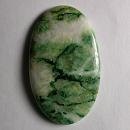|
|
||||||||||||||||
|
||||||||||||||||
|
||||||
|
|
|
|
Mariposite
(a
variety
of Muscovite) |
|
| | |
| Discovery date unknown; IMA status: Not Valid (a variety of Muscovite) | ||
|
| ||
|
Chemistry |
|
|
| |
|
K(Al,Cr)2(Al,Si)4O10(OH)2 | |
|
|
Potassium Aluminum Chromium Silicate Hydroxide |
|
Molecular Weight: |
521.21 gm |
|
Composition: |
Calcium |
23.07 % |
Ca |
32.28 % |
CaO |
|
|
Boron |
12.44 % |
B |
40.07 % |
B2O3 |
|
|
Hydrogen |
3.09 % |
H |
27.65 % |
H2O |
|
|
Oxygen |
61.39 % |
O |
|
|
|
|
|
100.00 % |
|
100.00 % |
= TOTAL OXIDE |
|
|
|
||||
|
Classification |
|
|
| |
|
Silicates (Germanates) | |
|
8/H.10-70 | |
|
|
9 : SILICATES (Germanates) |
|
Related to: |
Chromian-rich variety of Phengite (Muscovite). Mica Group. Muscovite Subgroup. |
|
Varieties: |
None |
|
Synonyms: |
Chrome-Phengite, Chromphengite |
|
|
|
|
Crystal Data |
|
|
|
|
|
Crystals tabular to columnar || [001], striated || {001}, pseudohexagonal or diamond-shaped. As stellate aggregates, plumose, globular; scaly, granular, compact massive. |
|
|
Composition plane {001}, twin axis [310], forming six-pointed stars. |
|
|
|
|
|
Physical Properties |
|
|
|
|
|
Perfect on {001}, partings on {110}, {010} |
|
|
Micaceous |
|
|
Laminae flexible and elastic; tough. |
|
|
2.5 |
|
|
2.77 - 2.88 (g/cm3) |
|
|
None |
|
|
Barely Detectable; GRapi = 140.52 (Gamma Ray American Petroleum Institute Units) |
|
|
|
|
|
Optical Properties |
|
|
|
|
|
Light to dark Green |
|
|
Opaque |
|
|
Vitreous to Pearly or Silky |
|
|
1.552 - 1.616 Biaxial ( ? ) |
|
|
0.0340 - 0.0420 |
|
|
Weak to Distinct; r > v |
|
|
Weak |
|
|
|
|
|
Occurances |
|
|
|
|
|
Geological Setting: |
A common rock-forming mineral, in phyllites, schists, and gneisses; in granites, granite pegmatites, and aplites. Formed from other minerals under hydrothermal conditions; may be detrital or authigenic. |
|
Common Associations: |
Quartz, Plagioclase, Potassic feldspar, Biotite, Tourmaline, Topaz |
|
Common Impurities: |
None |
|
Type Locality: |
Mariposa County, California, USA |
|
Year Discovered: |
Unknown |
|
View mineral photos: | |
|
|
|
|
More Information |
|
|
|
|
|
|
Mindat.org
(Mariposite) |
|
|
|
|
|
|
|
We
have not photographed our Mariposite gems
yet. Please
check back soon. |
